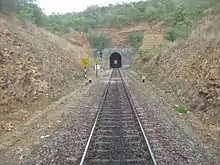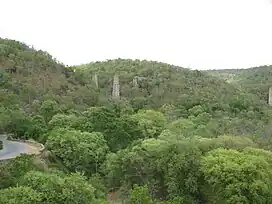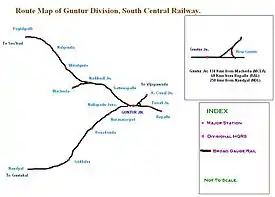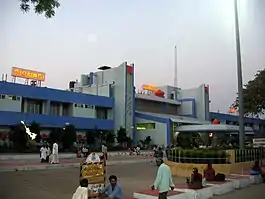 Rail Vikas Bhavan (Divisional Railway Manager Office) at Pattabhipuram of Guntur | |
| Overview | |
|---|---|
| Headquarters | Guntur |
| Reporting mark | GNT |
| Locale | Andhra Pradesh, India |
| Dates of operation | 1 April 2003– |
| Predecessor | Southern Railways |
| Technical | |
| Track gauge | Broad |
| Previous gauge | Metre |
| Electrification | 1989 |
| Length | 629.516 km (391.163 mi) |
| Other | |
| Website | official website |
Guntur Railway Division is one of the six divisions of the South Central Railway zone of Indian Railways.[1] The division was sanctioned in 1995–96 and was fully operational on 1 April 2003, with its headquarters at Guntur.[2][3] The Rail Vikas Bhavan in Pattabhipuram area of Guntur, serves as the office of Divisional Railway Manager.[4] The present divisional manager is M. Ramakrishna.[5]
History


The Krishna Canal-Nandyal (KCC-NDL) stretch was a part of the important east–west coast link that connected Margao in Goa to Masulipatnam in the erstwhile Madras Province of British India. It was originally built to Metre Gauge by the Southern Mahratta Railway (later the Madras and Southern Mahratta Railway-MSMR) during 1889–90.[6] The track passed through the Nallamala Hills and as a result quite a few major engineering works were undertaken in the course of the railroad construction, the most impressive of them being the massive Dorabavi Viaduct[7] and the Bogada Tunnel, both of them about 30 km from Nandyal. This section was converted to Broad Gauge during 1993–95. The gauge conversion was a difficult task owing to the difficult terrain. The old alignment between Gazulapalli and Diguvametta was abandoned and a new Bogada tunnel, about 1.6 km in length and a new Dorabavi Viaduct located at a much lower altitude were constructed at a huge expense. The railway passes through the historic Cumbum Tank, starting from Cumbum railway station and spread over an area of 7 km. It is one of the most picturesque valleys in Guntur-Nandyal section of South Central Railway.[8]
The Guntur-Macherla section was opened in 1930, by the Madras and Southern Mahratta Railway to serve the backward inner Telangana region. It too was originally metre gauge and was converted to 5 ft 6 in (1,676 mm) broad gauge in 1992–93.[9] This section was used for the transport of limestone, quartz &cement, primarily from Piduguralla, popularly known as the Lime City.[10] The section from Guntur to the coastal town of Repalle was built to the broad gauge by the Madras and Southern Railway in 1916. This line connected to the East Coast main line at Tenali. The section from Tenali to Repalle was owned by Guntur District Board until 1964. The foundation stone for the 152 km long Bibinagar-Nadikudi rail project that opened an alternative route to Secunderabad from Vijayawada and connected the interior of Telangana to Hyderabad was laid by the then Prime Minister of India, Indira Gandhi on 7 April 1974. The project was finally finished in 1989 and the line commissioned a year later.[11]
Two major bridges to span the Krishna River and Musi are located in this section. It is used by many south/east bound trains in a bid to decongest the heavily used Warangal-Vijayawada line. New rail lines are added in the region such as Nadikudi–Srikalahasti section, part of which comes under the division. This will be an alternate route to Chennai/Tirupati for Guntur City.[12][13]
Jurisdiction
The jurisdiction of the division covers the districts of Guntur, Kurnool, Prakasam in Andhra Pradesh and Yadadri Bhuvanagiri, Nalgonda in Telangana.[3] It has a total route length of 629.516 km (391.163 mi) and running track of 660.992 km (410.721 mi).[14] In Andhra Pradesh, it has a total route length of 484.78 km (301.23 mi) and in Telangana it is 144.94 km (90.06 mi).[15]
Sections and branch lines

The sections and branch lines route map breakup is as follows:
| Section | Distance (in km) |
Double/Single line | Traction |
|---|---|---|---|
| Guntur–Krishna Canal (excluding Krishna Canal) |
27.12 | Double | Electric |
| Guntur–Tenali (excluding Tenali) |
24.27 | Double | Electric |
| Pagidipalli–Nallapadu section (excluding Pagidipalli) |
243.92 | Single | Electric |
| Nallapadu–Nandyal section | 251.98 | Single | Electric |
| Tenali–Repalle (excluding Tenali) |
32.10 | Single | Electric |
| Nadikudi–Macherla | 35.01 | Single | Electric |
| Vishnupuram – Janpahad | 10.64 | Single | Electric |
| Other lines | |||
| Guntur – Nallapadu | 5.00 | Double | Electric |
| Guntur Byepass Line | 1.94 | Single | Electric |
| Total | 629.75 | 30.36 km of double line | 312.55 km of electrified track |
Source: SCR Railway Map 2018[16]
Under construction:
- Nadikudi-Srikalahasti railway line
Categorization of stations

The list includes the stations under the jurisdiction of Guntur railway division and classified based on their respective category.
| Category | No. of stations | Names of stations |
|---|---|---|
| A1 Category | 0 | — |
| A Category | 1 | Guntur Junction |
| B Category | 2 | Nandyal Junction and Nalgonda |
| C Category | 0 | — |
| D Category | 13 |
Cumbum, Donakonda, Giddalur, Macherla, Markapur Road, Mangalagiri, Mirylaguda, Nadikudi, Narasaraopet, Piduguralla, Repalle, Sattenapalle, Vinukonda |
| E Category | 43 |
New Guntur railway station |
| F Category | 13 |
Angalakuduru, Gudimetta, Gudipudi, GURZ (station code), Krishnamsettypalle, Lingamguntla, Mamdapur, Mandapadu, Pedakakani Halt, Penumarru, Rentachintala, Vellalcheruvu Halt, Zampini |
| Non-operational | 4 |
Bommaipalle, JNPD (station code), Kondrapole Halt, Nandipalli |
| Total | 75 | — |
Source:[3]
Performance and earnings
The division operates around 200 express, passenger and freight trains every day.[17] The primary commodity transported by the division is cement, clinker, food grains, besides coal and fertilizer. Other commodities include cotton, chillies, limestone, paddy, tobacco and timber waste.[17][18][19] In 2003, the freight earnings were ₹93 crore (US$12 million).[20] After a decade, it stands at ₹452 crore (US$57 million) in 2013–14. In 2008–09, the gross revenue was ₹237 crore (US$30 million), a decline in figures compared to previous fiscal of ₹272 crore (US$34 million), due to recession.[21] In the fiscal year 2018–19, it registered a growth of 69% freight earnings alone.[22]
| Revenue (in million rupees) |
2019-20[22] | 2018–19[22] |
|---|---|---|
| Passenger | 1570.4 | 1499.0 |
| Freight | 1934.4 | 2675.4 |
| Sundry | 204.5 | 207.0 |
- Gross includes passenger, freight, sundry and other coaching revenues
Awards and achievements
- Rail Vikas Bhavan, the office of the divisional railway manager was awarded platinum rating by Greening and Beautification Corporation of Andhra Pradesh.[23]
See also
References
- ↑ "A.P. gets new South Coast Railway zone". The Hindu. 28 February 2019. ISSN 0971-751X. Retrieved 2 May 2019.
- ↑ "Guntur Division". Retrieved 8 May 2014.
- 1 2 3 "Evolution of Guntur Division" (PDF). South Central Railway. p. 3. Retrieved 30 November 2015.
- ↑ "Guntur DRM office first in IR to get IGBC Green Campus Platinum Rating". Deccan Chronicle. 15 April 2018. Retrieved 2 May 2019.
- ↑ Staff Reporter (18 April 2019). "Guntur railway station gets facelift". The Hindu. Retrieved 23 April 2019.
- ↑ "Southern Mahratta Railway". Archived from the original on 8 January 2016. Retrieved 2014-05-08.
- ↑ "Dorabavi Viaduct". Retrieved 8 May 2014.
- ↑ Ibid
- ↑ "Macherla Railway Station". Retrieved 8 May 2014.
- ↑ "Grand start to Palnadu fest". The Hindu. Chennai, India. 20 December 2008.
- ↑ "Project Line Commissioned". Archived from the original on 4 November 2013. Retrieved 2014-05-08.
- ↑ "Nadikudi-Srikalahasti line". Retrieved 5 February 2019.
- ↑ "New line between Guntur and Tirupati". Retrieved 5 February 2019.
- ↑ "System Map 2018" (PDF). South Central Railway. Retrieved 23 April 2019.
- ↑ "Jurisdiction of Guntur Division" (PDF). South Central Railway. Retrieved 23 April 2019.
- ↑ "SCR Railway Map 2018" (PDF). South Central Railway. Retrieved 23 April 2019.
- 1 2 Ilyas, MD (21 December 2015). "Connected Guntur will spur growth". Deccan Chronicle. Guntur. Retrieved 14 March 2016.
- ↑ "Andhra Pradesh / Guntur News : Guntur railway division nets profit". The Hindu. 5 November 2013. Archived from the original on 5 November 2013. Retrieved 2 May 2019.
- ↑ ilyas, md (21 December 2015). "Connected Guntur will spur growth". Deccan Chronicle. Retrieved 2 May 2019.
- ↑ "Guntur Railway division earnings". The Hindu. Chennai. 26 April 2006. Retrieved 27 August 2007.
- ↑ "News Archives:". The Hindu. Guntur. 17 April 2008. Archived from the original on 5 November 2013. Retrieved 17 December 2015.
- 1 2 3 MN, Samdani (19 April 2019). "Guntur posts 69% growth in revenue from freight traffic | Vijayawada News – Times of India". The Times of India. Retrieved 2 May 2019.
- ↑ Staff Reporter (18 April 2019). "Guntur railway station gets facelift". The Hindu. Retrieved 2 May 2019.
16°18′04″N 80°26′36″E / 16.30111°N 80.44333°E


